Wesley L. McDonald | |
|---|---|
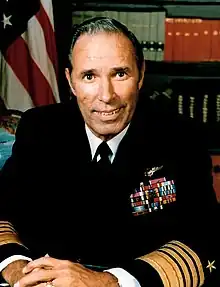 Official United States Navy photographic portrait of McDonald. | |
| Nickname(s) | "Wes" |
| Born | July 6, 1924 Washington D.C., U.S. |
| Died | February 8, 2009 (aged 84) Arlington County, Virginia, U.S. |
| Place of burial | |
| Allegiance | United States of America |
| Service/ | |
| Years of service | 1946–1985 |
| Rank | |
| Commands held | Attack Squadron VA-56 USS Coral Sea (1970–1971) U.S. Second Fleet U.S. Atlantic Fleet (1982–1985) U.S. Atlantic Command (1982–1985) Supreme Allied Commander Atlantic (1982–1985) |
| Battles/wars | Korean War[1] Vietnam War Invasion of Grenada |
| Awards | Defense Distinguished Service Medal Navy Distinguished Service Medal (2) Legion of Merit (2) Distinguished Flying Cross (2) Bronze Star |
| Other work | Business executive, advisor, fellow |
Wesley Lee McDonald[2] (July 6, 1924 – February 8, 2009) was a United States Navy admiral and naval aviator. He led the first air strike against North Vietnam after the Gulf of Tonkin incident and was the commander in charge of Operation Urgent Fury, the invasion of Grenada to rescue American citizens.
Early life and education
McDonald was born in Washington, D.C., on July 6, 1924. He graduated from the United States Naval Academy in 1946 and married his high school sweetheart.[3] He began his career as a naval aviator in 1950, serving in several carrier fighters and attack squadrons.[4] In 1964, McDonald was the skipper of Attack Squadron VA-56 flying A-4 Skyhawks aboard the USS Ticonderoga.[5][6][7] On August 5, 1964, he served as a flight leader for Operation Pierce Arrow, the first retaliatory strike against North Vietnam following the Gulf of Tonkin incident.[4] McDonald led his Skyhawk strike force against oil tanks at Vinh, destroying 90% of the facility.[8]
Career
Senior leader
McDonald's career led him to the highest levels of the United States Navy's command structure. He attended the National Defense University's National War College, graduating with the class of 1969.[9] From 1970 to 1971, he commanded the USS Coral Sea.[10] In 1972, as a rear admiral, McDonald was assigned as the carrier group commander.[11] He later served as deputy chief of Naval Personnel in Washington, D.C., in 1975.[4] In the fall of 1977, as COM2ndFLT, The U.S.S. Harry E. Yarnell (CG-17) served as his flagship during NATO exercises in the North Atlantic. In 1978, as Commander of the U.S. Second Fleet, he embarked on the USS Arthur W. Radford on the way to NATO exercises in the North Atlantic.[12] In 1982, McDonald was appointed Supreme Allied Commander Atlantic (SACLANT), one of two supreme commanders of the North Atlantic Treaty Organization.[13] At the same time, he assumed command of the U.S. Atlantic Command (CINCLANT) and U.S. Atlantic Fleet (CINCLANTFLT). In 1983, McDonald, in his role as CINCLANT, was placed in overall command of Operation Urgent Fury—the invasion of Grenada to rescue U.S. nationals.[14][15] He later summed up the success of the operation in an address before the House Armed Services Committee.
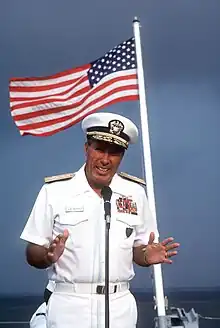
History should reflect that the operation was a complete success. All phases of the assigned mission were accomplished. U.S. citizens were protected and evacuated. The opposing forces were neutralized. The situation stabilized with no additional Cuban intervention. U.S. students have returned to resume their studies at the medical school and tourism is steadily increasing. And, most importantly, a lawful, democratic government has been restored.[14]
McDonald was the last United States Navy admiral to command all three organizations (Allied Atlantic Command, U.S. Atlantic Command, and U.S. Atlantic Fleet) at the same time.[16] He relinquished command of the U.S. Atlantic Fleet to Admiral Carlisle A.H. Trost, USN, on October 4, 1985,[16] and command of the U.S. Atlantic Command and Allied Atlantic Command to Admiral Lee Baggett Jr. in November 1985.[17]
Later life and death
After he retired from the Navy in 1985, McDonald played an active role in the aviation community in his leadership positions with the National Aeronautic Association (NAA) and the National Aviation Club (NAC). He helped orchestrate a merger of interests between NAA and NAC bringing benefits to both organizations. McDonald has also served on the boards of the U.S. Navy Memorial Foundation, the U.S. Naval Aviation Museum, and the Armed Services YMCA.[4] McDonald also often guest lectured an honors senior seminar led by Ford Foundation Fellow Professor Karl von Vorys at the University of Pennsylvania, and often took groups of students on personal tours of the Pentagon. His first wife, Norma, died in 1989.[3] McDonald later remarried and lived in Arlington, Virginia, with his wife, Helen until he died on February 8, 2009, in Arlington, Virginia. He has one son and three daughters and is buried at Arlington National Cemetery, in Arlington, Virginia.[18][19]
Awards and decorations
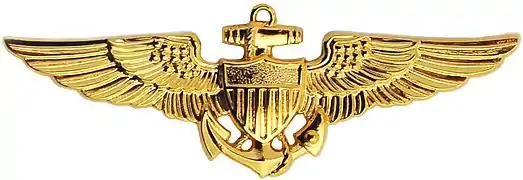 | ||
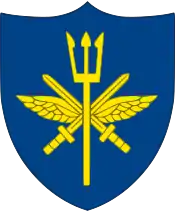 | ||
| Badge | Naval Aviator Badge | ||
|---|---|---|---|
| 1st Row | Defense Distinguished Service Medal | Navy Distinguished Service Medal with one gold award star | Legion of Merit with award star |
| 2nd Row | Distinguished Flying Cross with award star | Bronze Star with Valor device | Defense Meritorious Service Medal |
| 3rd row | Meritorious Service Medal | Air Medal with three award stars | Joint Service Commendation Medal |
| 4th Row | Navy and Marine Corps Commendation Medal with Valor device | Navy Unit Commendation with two bronze service stars | American Campaign Medal |
| 5th Row | World War II Victory Medal | Navy Occupation Service Medal | National Defense Service Medal with service star |
| 6th row | Antarctica Service Medal | Armed Forces Expeditionary Medal | Vietnam Service Medal with three service stars |
| 7th Row | Vietnam Gallantry Cross Unit Citation | Vietnam Campaign Medal | Navy Rifle Marksmanship Ribbon |
| Badge | Supreme Allied Commander Atlantic | ||
Honors and recognition
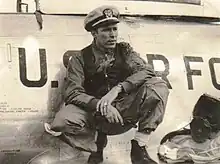
(USN Photo)
McDonald's awards include the Defense Distinguished Service Medal, the Navy Distinguished Service Medal, the Legion of Merit, the Distinguished Flying Cross, the Air Medal, and awards from several European and South American nations.[9]
In 1990, McDonald was elected Grand Paramount Carabao, leader of the ![]() Military Order of the Carabao.[20] In 2004, McDonald was presented with the National Aeronautic Association's Cliff Henderson Award for his 56 years of support to American aviation.[4][21] In 2007, the National Aeronautic Association renamed its Elder Statesman of Aviation Award in honor of McDonald, who was a past chairman of the organization.[22] McDonald was a Senior Fellow of the National Defense University.[9]
Military Order of the Carabao.[20] In 2004, McDonald was presented with the National Aeronautic Association's Cliff Henderson Award for his 56 years of support to American aviation.[4][21] In 2007, the National Aeronautic Association renamed its Elder Statesman of Aviation Award in honor of McDonald, who was a past chairman of the organization.[22] McDonald was a Senior Fellow of the National Defense University.[9]
Several awards are named in honor of McDonald, including:
- The Admiral Wesley L. McDonald Leadership Award, jointly sponsored by Strike Fighter Wing Pacific, the San Joaquin Valley Squadron of the Association of Naval Aviation (ANA), and the Greater Kings County Navy League.[23]
- The Wesley L. McDonald Elder Statesman of Aviation Award, sponsored by the National Aeronautic Association.[22]
Notes
- ↑ "McDonald, Wesley L". ANCExplorer. U.S. Army. Retrieved March 15, 2021.
- ↑ Register of Commissioned and Warrant Officers of the United States Navy and Reserve Officers on the Active-Duty List. Bureau of Naval Personnel. October 1, 1984. p. 1. Retrieved March 15, 2021.
- 1 2 Norma Joy McDonald Dies. The Washington Post, July 26, 1989, retrieved February 15, 2008.
- 1 2 3 4 5 "Cliff Henderson Award Notice". Archived from the original on August 20, 2004. Retrieved 2008-03-09.
{{cite web}}: CS1 maint: bot: original URL status unknown (link). Atlantic Flyer, August 20, 2004, retrieved February 4, 2008. - ↑ Commander of Attack Squadron VA-56. James Stockdale Biography, retrieved February 14, 2008.
- ↑ Alvarez, Chained Eagle, p. 9.
- ↑ Grossnick, Dictionary of American Naval Aviation Squadrons, p. 109.
- ↑ Mersky, US Navy and Marine Corps A-4 Skyhawk Units of the Vietnam War, Chapter 3.
- 1 2 3 McDonald Biography Archived 2008-08-03 at the Wayback Machine. Stratizon Board of Advisors, retrieved February 16, 2008.
- ↑ USS Coral Sea Commanding Officers Archived 2007-09-28 at the Wayback Machine. USS Coral Sea Tribute Site, retrieved February 4, 2008.
- ↑ Birzer, US Navy A-7 Corsair II Units of the Vietnam War, p. 73.
- ↑ Embarked on USS Authur W. Radford. Haze Gray & Underway DD-968 page, retrieved February 14, 2008.
- ↑ NATO, Senior Officials in the NATO military structure, p. 9, retrieved February 14, 2008.
- 1 2 Grenada: Operation Urgent Fury FAQ Archived 2008-03-04 at the Wayback Machine Naval Historical Center, retrieved February 14, 2008.
- ↑ Cole, Operation Urgent Fury Grenada, p. 3.
- 1 2 SACLANT Historical Note Naval Historical Center, retrieved February 4, 2008.
- ↑ NATO SACLANT Commanders NATO web site, retrieved March 28, 2008.
- ↑ "Burial Detail: McDonald, Wesley L. (Section 7A, Grave 130-D)". ANC Explorer. Arlington National Cemetery. (Official website).
- ↑ Sullivan, Patricia, "Admiral Led Grenada Invasion", Washington Post, February 12, 2009, p. B7.
- ↑ Past Grand Paramount Carabaos Archived 2011-07-22 at the Wayback Machine Military Order of the Carabao, retrieved February 4, 2008
- 1 2 Elder Statesman of Aviation Award Renamed to Honor McDonald Archived 2008-02-07 at the Wayback Machine. National Aviation Club, retrieved February 7, 2008.
- ↑ McDonald Leadership Award
References
- Alvarez, Jr., Everett; Pitch, Anthony S. (2005). Chained Eagle: The Heroic Story of the First American Shot Down Over North Vietnam (PDF). Brassey's Inc. ISBN 1-57488-558-8. Retrieved 2008-03-08.
- Birzer, Norm; Mersky, Peter (2004). US Navy A-7 Corsair II Units of the Vietnam War. Osprey Publishing. ISBN 1-84176-731-X. Retrieved 2008-03-08.
- Cole, Ronald H. (1997). "Operation Urgent Fury Grenada" (PDF). Joint History Office. Retrieved 2008-02-15.
{{cite journal}}: Cite journal requires|journal=(help) - Grossnick, Roy A. (1995). "Chapter 2 Attack Squadron Histories for VA-54 to VA-56" (PDF). Dictionary of American Naval Aviation Squadrons, Volume 1 (PDF). Naval Historical Center. ISBN 0-945274-29-7.
- Mersky, Peter (2007). US Navy and Marine Corps A-4 Skyhawk Units of the Vietnam War 1963–1973. Osprey Publishing. ISBN 978-1-84603-181-6. Retrieved 2008-03-08.
- North Atlantic Treaty Organization (2000-12-05). "Senior officials in the NATO military structure, from 1949 to 2001" (PDF). Retrieved 2008-02-14.
{{cite journal}}: Cite journal requires|journal=(help)
External links
- McDonald, Wesley L. (2001). "Western Maritime Defences". Archived from the original on November 16, 2007. Retrieved February 6, 2008.
{{cite journal}}: Cite journal requires|journal=(help) - Hevesi, Dennis (February 23, 2009). "Wesley McDonald, Who Planned for Grenada, Dies at 84". The New York Times. p. A25. Retrieved May 23, 2009.
- Sullivan, Patricia (February 16, 2009). "Wesley L. McDonald dies at 84; 4-star Navy admiral led 1983 U.S. invasion of Grenada". The Los Angeles Times. Retrieved May 23, 2009.
- "Wesley L. McDonald". at ArlingtonCemetery.net. 17 December 2022. (Unofficial website).